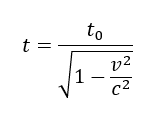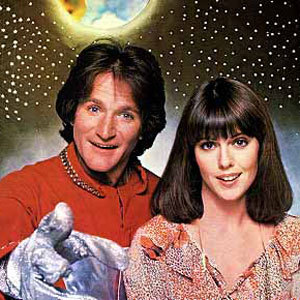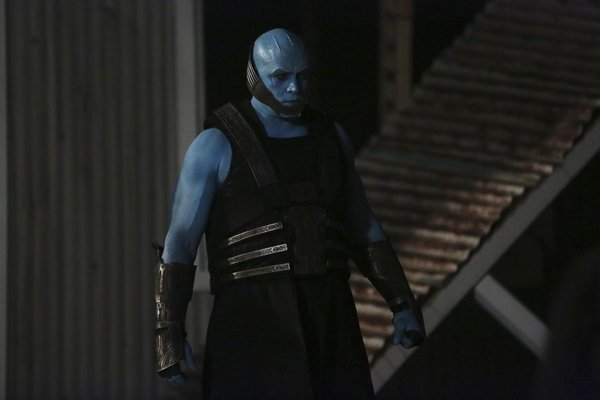 Consider X-O Manowar’s Aric the Visigoth and Mork from Ork as brothers.
Consider X-O Manowar’s Aric the Visigoth and Mork from Ork as brothers.
Okay – that’s stretching it. They’ve got one thing in common though. Both have experienced time travel in the manner that Albert Einstein allows – which means that it’s straight-up, legit time travel. One-direction (into the future), accomplished through one of the features of Einstein’s special relativity.
Buckle up and hold on to your brains, because we’re going to get into The Science of Relativity and Time Dilation.
Let’s start with Aric of Dacia, the star of Valiant’s X-O Manowar (series is available in trades at your local comic shop or here on Comixology). A hot-tempered Visigoth, Aric was captured by the aliens known as the Vine in 402 A.D., when the Visigoths were in battle with the Romans at the Battle of Pollentia – a real battle. The Vine, needing slave races to nurture their gardens, grabbed Aric and a handful of his fellow Visigoths, threw them on their colony ship and headed out into space at relativistic speeds. Relativistic speed is something that you, me, and even Usian Bolt will never reach. It’s a speed that’s a significant proportion of the speed of light (3.0 x 108 meters/second), so as a result, Einstein’s special relativity must be taken into account. Simple form – special relativity = new rulebook for physics of things moving at a constant, very high speed in a straight line. General relativity, which we’ll come to later = mass causes distortions in spacetime, which affects space and, well…time.
First off – special relativity. Einstein’s formula that’s used to calculate the changes that occur as objects approach the speed of light looks like this:
Where v is velocity, and c is the speed of light, 3.0 x 108 m/s. It does get tweaked a little depending upon what variable you’re talking about.
In short, and without turning this into a full-on discussion on special relativity, three changes occur to an object as it nears the speed of light:
- Its mass increases
- The object contracts in the direction of travel
- Time for the object (and those inside the object) slows down.
Plugging numbers into the equation will give you the change in your variable (mass, length, time). For example, if the object is traveling at .9c (nine tenths the speed of light), the resultant factor is 2.294. This means that:
- The mass of the object would increase by a factor of 2.294
- The object would contract by a factor of 2.294, meaning that – for example, the 725 meter USS Enterprise (Kelvin Timeline – the one created in the 2009 Star Trek film) would contract to 316 meters (725/2.294) if it were traveling at .9c in a universe that followed the laws of special relativity…which Star Trek plays fast and loose with. Oh – and don’t worry about Kirk, Spock and everyone else – they would contract in the direction of travel an equal amount as well.
- And what we’re talking about here – if you are, or are on the object, 1 year for you would be 2.294 years for someone back on earth, or from wherever your ship launched.
We’re only looking at the phenomenon of time dilation today, but safe to say, as your speed gets closer and closer to the speed of light, the object’s mass increases dramatically and it would contract dramatically as well. As best we understand it, if an object was moving at the speed of light, it’s mass (and energy) would be infinite, and it would be contracted to a point.
But we’re not talking about that right now.
Before we go on though, it’s important to note that time dilation is real, and it happens at all speeds as it turns out. It’s been proven in experiments, such as the Hafele-Keating experiments of 1971, where extremely precise atomic clocks were placed on airplanes which then flew in opposite directions. When compared with clocks on the ground, the airline clocks showed differences, based on their relative motion which matched the predictions from special relativity. Airline pilots who spend longer periods of time traveling faster than most of us benefit from this – but only in miniscule amounts. Traveling at 550 mph for 6 hours, roughly the time to fly across the Atlantic, slows time for the pilot and passengers by 0.0000001 seconds. It’s extremely small and measurable with the proper clocks, but it does happen.
So – we’re going to assume that the Vine in X-O Manowar have managed to overcome the mass issue, have somehow tapped into a vast energy source, and also aren’t bothered by the contraction. Let’s focus on time dilation experienced by Aric.
According to the storyline in X-O Manowar, Aric and his fellows were on board the Vine ship (which was moving at relativistic speed) for “several” years. After a failed attempt or two, Aric finally led a successful rebellion against his captors, during which he gained control of the sentient X-O Manowar armor. In the ensuring battle, Aric was jettisoned outside the Vine ship and nearly killed. While unconscious, he dreamed of his home, his wife and Rome. Taking his delirious muttering as orders, the armor teleported Aric to Rome.
But it was Rome of 2012 (when the comic book was published). 1,610 years after he was taken.
If we say that Aric was on the Vine ship for 7 years, then 230 years passed on earth for each year that Aric and his fellow Visigoths experienced on board the Vine ship. Just how fast was that Vine ship going anyway?
We’re going to turn it over to Scott at Nerd Sync who has a video which explains all of this…in video! It’s a solid 9 minutes and 43 seconds of the science of time dilation which will answer any questions you might have about why this stuff happens anyway. So without further ado, here’s Scott…
So the Vine ship was moving pretty fast – nearly at the speed of light – 2.998 x 108 m/s.
So where did that ship go?
If we assume this is all about special relativity, and it was moving at a constant 2.998 x 108 m/s for the time they were gone, they traveled a total of 1610 light years – the speed of light is constant across all frames of reference. A light year of course, is the distance light travels (moving at the speed of…light) in a year, about 5.9 trillion miles. If you drew a circle around the earth that had a radius of 1610 light years…well…the Vine ship could have been anywhere on that circumference.
 Alpha Centauri is about 4.37 light years away, so the Vine were well past that, past Barnard’s Star, past Sirius and all the stars in our local neighborhood. Looking at the infographic from Space.com (click the link for actual distances), they were pretty far away. Betelgeuse (the red giant in the constellation Orion) is 642.5 light years away, so they were past that too. They were outta here.
Alpha Centauri is about 4.37 light years away, so the Vine were well past that, past Barnard’s Star, past Sirius and all the stars in our local neighborhood. Looking at the infographic from Space.com (click the link for actual distances), they were pretty far away. Betelgeuse (the red giant in the constellation Orion) is 642.5 light years away, so they were past that too. They were outta here.
If you saw Interstellar, then you know that there is one other way to experience time “travel” using relativity – get near an object with a lot of mass. In his explanation of general relativity Einstein demonstrated that mass warps spacetime in a manner such that the stronger the pull of gravity, the greater the slowing of time.
On earth, this phenomenon is seen in the satellites that provide us with GPS coordinates – due to the surface of the earth being closer to the center of mass of the earth, time moves slower on the surface than it does in the orbits of satellites – 20,000 km above us, moving about 14,000 km/hr. Side note – as you’d expect, special relativity means that the clocks on the satellites tick slower than those on the surface – satellite clocks are about 7 microseconds a day slower than their counterparts on the surface.
But due to general relativity, the clocks in GPS satellites tick 45 microseconds faster than those on the ground, since they are further away from the mass of the earth. As a result of the time dilation of special relativity and the general relativity slowdown, the clocks in GPS satellites differ from those on the surface by about 38 microseconds per day (45 – 7 = 38). GPS satellites correct for both, and as a result, can give us accurate locations. Without the corrections in time due to these two relativistic effects, satellite-based GPS would be worthless.
By the way – when you combine the time dilation of special relativity with the effects of general relativity, you can get younger siblings. Although astronauts Mark and Scott Kelly are twins, Scott is now slightly younger than Mark, thanks to the year he spent on board the International Space Station, traveling at 17,500 miles per hour at an altitude of 249 miles. Both the speed at which the ISS was traveling, as well as it’s distance away from the earth’s mass contributed to Scott’s time moving “slower” than Mark’s – who was on the surface of the earth for the year.
But back to the idea of mass slowing time – the more mass, the slower time passes for the object (or person near the mass). Near a neutron star, a few hours for a traveler would be a day for an earth-based observer. Near a black hole, the effects would be much larger – as it was a major plot point in Interstellar.
While special relativity slows time while the object is moving at relativistic speeds, general relativity slows time for the object or traveler as they near an object with tremendous mass. Near a giant black hole, minutes or hours for an explorer could equal decades or centuries for those on earth.
While it wasn’t shown in X-O Manowar, traveling to and parking at a black hole would be a valid method of time travel – in fact, this method was used in another Valiant comic – Ivar, Time-Walker. More on that in a future installment.
And for our other example of time dilation via special relativity, we turn to the late Robin Williams whose breakout role was the alien Mork from Ork. Williams first played the character when he appeared as a guest star on Happy Days season 5 in February of 1978. Mork had been sent to earth from his home planet of Ork to collect a typical, sample earthling (Richie Cunningham) to bring back for display in a zoo.
The Fonz stopped Mork, and with his Orkian powers, Mork made the cast forget the encounter, but he was then assigned to travel to earth in the fall of 1978 and continue his mission – observing earthlings by posing as one and living among them. There’s no reason to think that Mork just “science fictionally” traveled in time, but rather, he was “called back” to return in Boulder, Colorado in 1978. In fact, in the debut episode of the series Mork and Mindy, Mork recalls that he had “visited” earth once before.
So – if we play with this as a time dilation problem…
How long was Mork gone from earth? Happy Days ran for 11 seasons, with each year of the show tracking roughly the same time between 1955 to 1965. February of season 5 of Happy Days would have corresponded to February of 1960. Mork and Mindy debuted in the fall of 1978, so Mork “traveled” 18 years into the future. Let’s assume that roughly 1 year passed for Mork in his spaceship (less time travelling in space wouldn’t make too much difference in the final value). Since we know how much time passed on earth – 18 years – we can use the formula from above with respect to time:
Where:
t = time that has passed for the stationary observer (on earth) = 18 years
t0 = time in the rest frame (experienced by the traveler) = 1 year
Solving the equation for v, we get the velocity of Mork’s spaceship to be 299,329 km/s or 2.993 x 108 m/s.
If Mork did spend a year of his time on the ship, he would have traveled (roughly) six months out and six months back – using inertial dampeners. Always use inertial dampeners when traveling in space. And of course, we’d just assuming he was moving at a constant 2.993 x 108 m/s, without any acceleration or deceleration. Those are some rough pills to swallow, but by doing so, it makes for a more interesting problem.
We can use the same approach with Mork as we did with the Vine when trying to figure out where he went. Again the speed of light is constant, so if he was gone from earth for 18 years, he traveled roughly 18 light years away from earth (though it only took him a year), to come back circa 1978. Maybe he went nine light years our and then nine back. Maybe he went home to Ork at relativistic speed, hung out and then returned at relativistic speed. If we assume Ork to be somewhere within the nine light years Mork possibly could have traveled in that time (nine out + nine back = 18 light years), Ork is local to earth.
Oh, and no – just in case you’re going there, the nearest black hole is several thousand light years from earth. And one more thing – yes, Mork did return to Happy Days, so you could argue that he figured out how to return to the past, but…the less said about that episode the better. We’ll ignore it.
So what does all of this mean, aside from relativity, general and special is kind of mind-blowing?
Well, time travel, at least into the future is possible. We just don’t have the technology to pull it off yet.
What about if we’re talking about a space-faring species, like the Vine in X-O Manowar or the Kree of Marvel that seems to like “seeding” planets and then coming back millions or thousands of years later to see how the experiments are doing? Looking at this behavior through the lens of special relativity and using the Inhuman-creating Kree as an example, once life is detected on earth, all they need to do is show up, mess with it, head away at relativistic speed for a set amount of time, and then return to earth – or rather return to where earth would have moved to, since earth’s not sitting still – and check the progress.
Same idea if the planet whose life you’re messing with it near a large enough black hole to serve the same purpose. Infect, travel to black hole, play epic game of Monopoly, head back to planet to see the results. It’s an efficient way to muck with life in the universe, although culturally, it would be something very different than what’s been shown in science fiction and comics – the Kree “seeders” could never return to Hala (their homeworld). Just as millions of years are passing on earth while they travel, millions of years are passing on Hala. Quite literally – in the Thomas Wolfe sense – they can’t go home again. Not to mention, the technology they used to mess with the life forms they found would be hopelessly outdated. Whole philosophies and religions and wars could have seized the planet while they were out.
If you sign up for a Vine or Kree mission to seed planets in the nearby galaxies or throughout the universe, and if your universe obeys Einstein’s special relativity – you’d better like the other folks on your ship, because they’re not just your crew, they’re your fellow time travelers, and the only people in the entire universe with whom you have anything in common.
















